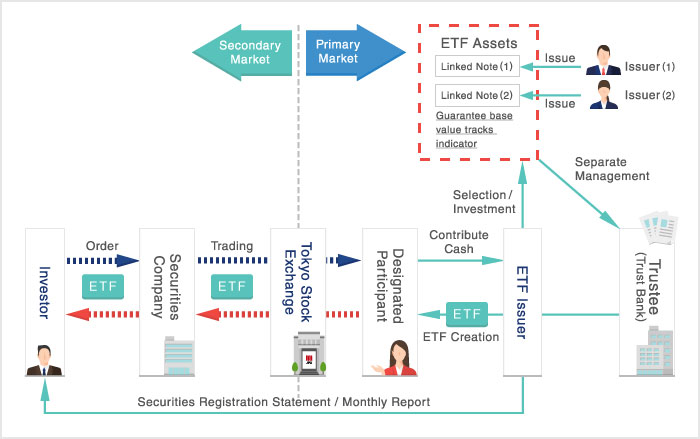Risks (ETFs)
Linked Note-type ETF
Linked Note-type ETFs are ETFs for which the fluctuation rate of net assets per unit is the same as the fluctuation rate of an underlying indicator by investing in bonds (linked notes) primarily issued by financial institutions for the purpose of producing investment results which track such underlying indicator. The redemption price of the linked note which the ETF uses as an underlying investment is guaranteed by the linked note issuer to track the movements of an indicator, and by holding the linked note, the fluctuation rate of the ETF's net assets per unit tracks that of the indicator.
While disparity (tracking errors) between the fluctuation rates of the net assets per unit and the underlying indicator does not occur for linked note-type ETFs, there is credit risk associated with the issuer of the linked note.

Mechanism of Linked Note ETFs
- ・The above is the mechanism in cases of cash creation/cash cancellation-types. There are also linked note-type ETFs which are cash creation/underlying asset (linked note) exchange-type.
- ・Actual exchange of cash/securities is conducted by a trustee company (trust bank) under the direction of the ETF issuer.
Credit Risk of Linked Note-type ETFs and Notes when Investing
Though many linked note-type ETFs invest in linked notes which have a high convertibility close to their maturity date, the base value of the ETF may decline due the linked note’s price dropping or being nullified as a result of bankruptcy or deterioration of financial situation on the part of the linked note’s issuer.
When investing in linked note-type ETFs, it is important to confirm the health of the linked note’s issuer financial institution (for example, financial conditions, credit rating, etc.) and appropriately understand the credit status of such issuer.
ETFs Investing in Linked Notes
There are currently no linked note-type ETFs listed or scheduled to be listed on Tokyo Stock Exchange.



